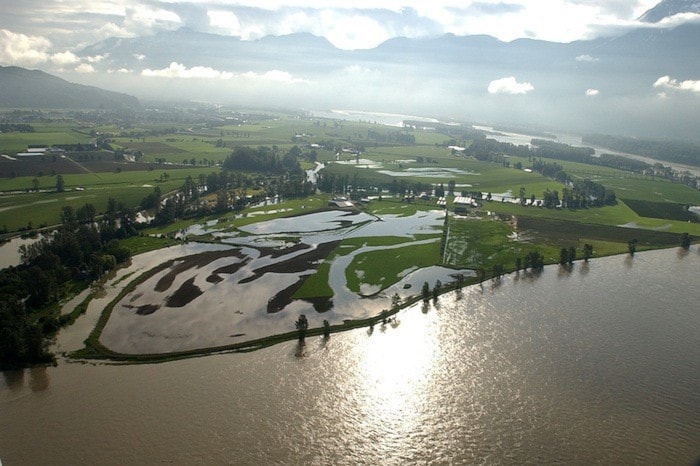A broad coalition of local and senior governments and other interests have joined forces to craft a coordinated strategy to safeguard the Lower Mainland from a catastrophic flood.
The Lower Mainland Flood Management Strategy aims to pull together an action plan with costs within two years to begin the process of raising dikes and improving other flood defences in the years ahead.
It's unclear how the billions of dollars in needed work will be raised but advocates hope a regional approach will prove more logical than leaving individual municipalities to work in isolation on flood planning and lobbying for grants.
The initiative led by the Fraser Basin Council was announced Tuesday and will focus on the risk of Fraser River flooding and coastal flooding from winter storm surges, which are expected to be amplified by a rising sea level.
RELATED STORIESValley dikes too low to withstand major Fraser River floodFraser River risks threaten economy: report
Technical work is to begin later this year to better identify areas of the region that are most vulnerable to flooding.
Fraser Basin Council chair Colin Hansen said a priorized strategy of what flood defence works are needed most urgently would guide spending.
A blueprint for deliberate, planned upgrades would aim to avoid a repeat of 2007, when the Fraser threatened to flood and politicians frantically dispatched hundreds of dump trucks to raise dikes as an emergency action.
"We did not know whether we were putting those dump truck loads in the most important places or not," Hansen said.
"We threw money at the problem on an urgent basis. We need to make sure taxpayers' dollars are spent effectively, targeting the highest risk areas first and dealing with the secondary concerns as we go forward."
Part of the case for a regionally agreed strategy is because flood water pushed back in one area will flow to another.
Just building higher dikes in the Fraser Valley could simply direct more water at Richmond, Hansen said.
Dikes are sometimes maintained by different municipalities on either side of a river – such as the Pitt River between Coquitlam and Port Coquitlam. If just one side is built higher to new standards, the other side would flood first in high water.
"Everything that is done has consequences somewhere else," Hansen said. "That's why this has to be an integrated plan."
Federal and provincial ministers pledged support, noting a Fraser flood has the potential to be the worst natural disaster in Canadian history, with 300,000 residents and $50 billion in development at risk on the river's floodplain.
Also backing the plan was Sto:lo Grand Chief Doug Kelly, who said aboriginal communities' pleas for help during floods in 1989 and 1990 were mired in "jurisdictional warfare" between the provincial and federal governments.
Adding to the sense of urgency are new reports released by the province last week that project major floods will be more frequent and severe as a result of climate change, and warned most dikes in the Fraser Valley are not high enough.
"It makes this much more real," said Fraser Basin Council executive director David Marshall.
He said a major flood could cut off the rest of Canada from Asia-Pacific trade and sterilize the fertile farmland soil of the Fraser delta with salt water.
"Like New Orleans, it could take years or even decades to fully recover," Marshall said. "It's always been in the past that someone else will look after it. Well, those days are done."
Hansen noted nobody knows how much time the region has to bolster its defences.
He pointed to a flood like the devastating one of 1894, thought to have been a one-in-200-year flood that new studies now project may come once every 50 years.
"We don't know whether that's next year or 49 years from now."
Some Fraser Valley politicians fear the strategy may focus too heavily on raising dikes and not enough on the use of dredging of the Fraser to deal with the steady deposition of gravel that creates less room for water in the channel over time.
"Dredging seems to be a dirty word as far as the Fraser Basin Council is concerned," said District of Kent Coun. Lorne Fisher.

Flooding of the Fraser River near Chilliwack in 2007. Black Press file photo
